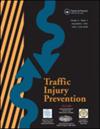Self-reported drink driving, enforcement, crashes, and crash reporting: A 6-country comparison
IF 1.6
3区 工程技术
Q3 PUBLIC, ENVIRONMENTAL & OCCUPATIONAL HEALTH
引用次数: 0
Abstract
Objective
The objective of this study was to compare drink driving and related road safety issues in 2 urban areas of 6 countries and develop an equation for estimating the rate of crash underreporting to the police in urban areas of countries that lack this information.
Methods
This study is a secondary analysis of 1 to 2 waves of surveys in pairs of matched medium-sized cities in Belgium, Brazil, China, Mexico, South Africa, and Ohio, United States; the surveys supported evaluation of local alcohol harm reduction efforts. Data were from 2017 to 2019 except 2023 for Mexico. Mailed surveys in Ohio and household interviews elsewhere of quota samples matched to census data yielded 23,240 completed interviews. Relevant questions covered drinking, driving under the influence of alcohol (DUI), DUI enforcement, and, except in South Africa, road crashes. GLM regression provided an equation for estimating police reporting rates of urban injury and no-injury crashes from a country’s purchasing-power parity–adjusted gross domestic product (GDP) per capita.
Results
The percentage of drivers driving unlicensed was 30% in Mexico and South Africa, 15% in Brazil, 8% in China, and <1% elsewhere. Among adults who both drove and drank, self-reported urban DUI rates ranged from 12% in China to 53% in South Africa, with 4 countries between 18% and 26%. Among those reporting DUI, the percentage stopped by police for doing so was 14% in Belgium, 15% in Brazil, 25% in China, 31% in Mexico, 45% in South Africa, and only 3% in Ohio. The surveys yielded data on 380 urban crashes. Past-year crash involvement was 2% to 3% in Belgium and China and 5% to 6% elsewhere. The 10% injury rate in Ohio crashes was significantly below the 24% to 35% rates elsewhere. Injury crashes were almost universally reported except in Brazil (60% reported). Only 49% to 56% of non-injury crashes were reported, except in Ohio (73%). Perceived alcohol-involved crash rates of 18% to 19% in Belgium and Ohio were significantly lower than the 32% reported in Brazil, 41% in China, and 57% in Mexico. In the regression, GDP per capita and injury involvement were positively associated with police crash reporting.
Conclusions
Our equation more closely approximates urban police crash reporting rates than prior studies that assumed that they matched U.S. data. DUI enforcement is weak/ineffective in urban Ohio. With suggested adjustments, our survey questions should be usable in other international road safety and DUI studies.
自报酒驾、执法、撞车和撞车报告:6 国比较。
研究目的本研究的目的是比较 6 个国家 2 个城市地区的酒后驾驶和相关道路安全问题,并建立一个等式,用于估算缺乏相关信息的国家城市地区向警方少报车祸的比率:本研究是对比利时、巴西、中国、墨西哥、南非和美国俄亥俄州一对匹配的中型城市的 1 到 2 波调查进行的二次分析;这些调查支持对当地减少酒精危害工作的评估。数据时间为 2017 年至 2019 年,墨西哥为 2023 年。俄亥俄州的邮寄调查和其他地区与人口普查数据相匹配的配额样本入户访谈共完成 23,240 次访谈。相关问题涉及饮酒、酒后驾驶(DUI)、酒后驾驶执法以及道路交通事故(南非除外)。GLM 回归提供了一个等式,用于根据一个国家经购买力平价调整后的人均国内生产总值(GDP)估算城市受伤和无受伤交通事故的警方报告率:结果:墨西哥和南非的无证驾驶比例为 30%,巴西为 15%,中国为 8%:与之前假定与美国数据相匹配的研究相比,我们的等式更接近城市警方的车祸报告率。俄亥俄州市区的酒驾执法力度较弱/效果不佳。经过建议的调整,我们的调查问题应可用于其他国际道路安全和酒驾研究。
本文章由计算机程序翻译,如有差异,请以英文原文为准。
求助全文
约1分钟内获得全文
求助全文
来源期刊

Traffic Injury Prevention
PUBLIC, ENVIRONMENTAL & OCCUPATIONAL HEALTH-
CiteScore
3.60
自引率
10.00%
发文量
137
审稿时长
3 months
期刊介绍:
The purpose of Traffic Injury Prevention is to bridge the disciplines of medicine, engineering, public health and traffic safety in order to foster the science of traffic injury prevention. The archival journal focuses on research, interventions and evaluations within the areas of traffic safety, crash causation, injury prevention and treatment.
General topics within the journal''s scope are driver behavior, road infrastructure, emerging crash avoidance technologies, crash and injury epidemiology, alcohol and drugs, impact injury biomechanics, vehicle crashworthiness, occupant restraints, pedestrian safety, evaluation of interventions, economic consequences and emergency and clinical care with specific application to traffic injury prevention. The journal includes full length papers, review articles, case studies, brief technical notes and commentaries.
 求助内容:
求助内容: 应助结果提醒方式:
应助结果提醒方式:


